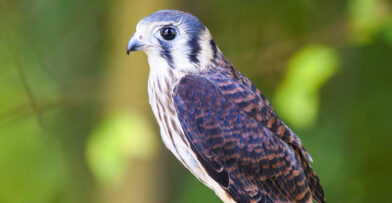Schlitz Audubon is excited to welcome a new bird into our Raptor Program: Otis, the Peregrine Falcon (Falco peregrinus).
How Otis Became an Educational Ambassador
Otis arrived at the Raptor Education Group, Inc (REGI) in Antigo, WI as a juvenile in 2013 with a severe left-wing injury. Wildlife rehabilitators at REGI believe that he collided with a phone wire mid-flight causing acute damage. Otis underwent surgery to repair his injuries, but the wing did not heal properly on its own, causing him to permanently lose his ability for strong flight. Otis was deemed non-releasable to the wild and remained at REGI as an educational bird until early 2020. Last year, he moved into the Wildlife in Need Center in Oconomowoc, WI to continue his work as an educational ambassador. With a strong collaboration between Schlitz Audubon’s Raptor Program and the Wildlife in Need Center, the decision was made to transfer Otis to us, and we are grateful for the wonderful opportunity to bring him into our program.
About the Species
Peregrine Falcons are one of the largest falcon species found in the United States, weighing in at an average of 2 1/2 pounds with a 3 1/2 foot wingspan. Adults have a dark, blue-grey head and feathers with a lighter, barred chest. Their slate grey wings and tail are built for aerodynamics and are long, stiff, and sharply pointed. These birds are fierce aerial predators and are most famous for their incredible speed, claiming a top diving speed of 240 mph. As a mid-flight hunter, Peregrine Falcons prefer perching and nesting on tall structures such as cliffs, bluffs, and skyscrapers where they can scan the horizon for their prey. The majority of their diet consists of small to medium-sized birds such as ducks, pigeons, and starlings.
Conservation of Peregrine Falcons
Peregrine Falcons have been listed as an endangered species in the state of Wisconsin since 1975. Their species was at risk for many years due to poisoning from a pesticide called DDT which caused their eggshells to weaken and break. The use of DDT has since been banned in the United States and their populations have slowly increased over the past few decades thanks to the integral implementation of nest boxes across the state. Companies such as We Energies have supported Peregrine Falcon populations by building nest boxes in their power plants, which act as ideal nesting sites due to their tall structure.
In our Raptor Program, Otis will help teach the public about the Peregrine Falcon’s important story of conservation and the dangers of toxin biomagnification. He will also provide the one-of-a-kind experience of seeing this beautiful species up close!


